2014 NISSAN TEANA sensor
[x] Cancel search: sensorPage 2609 of 4801
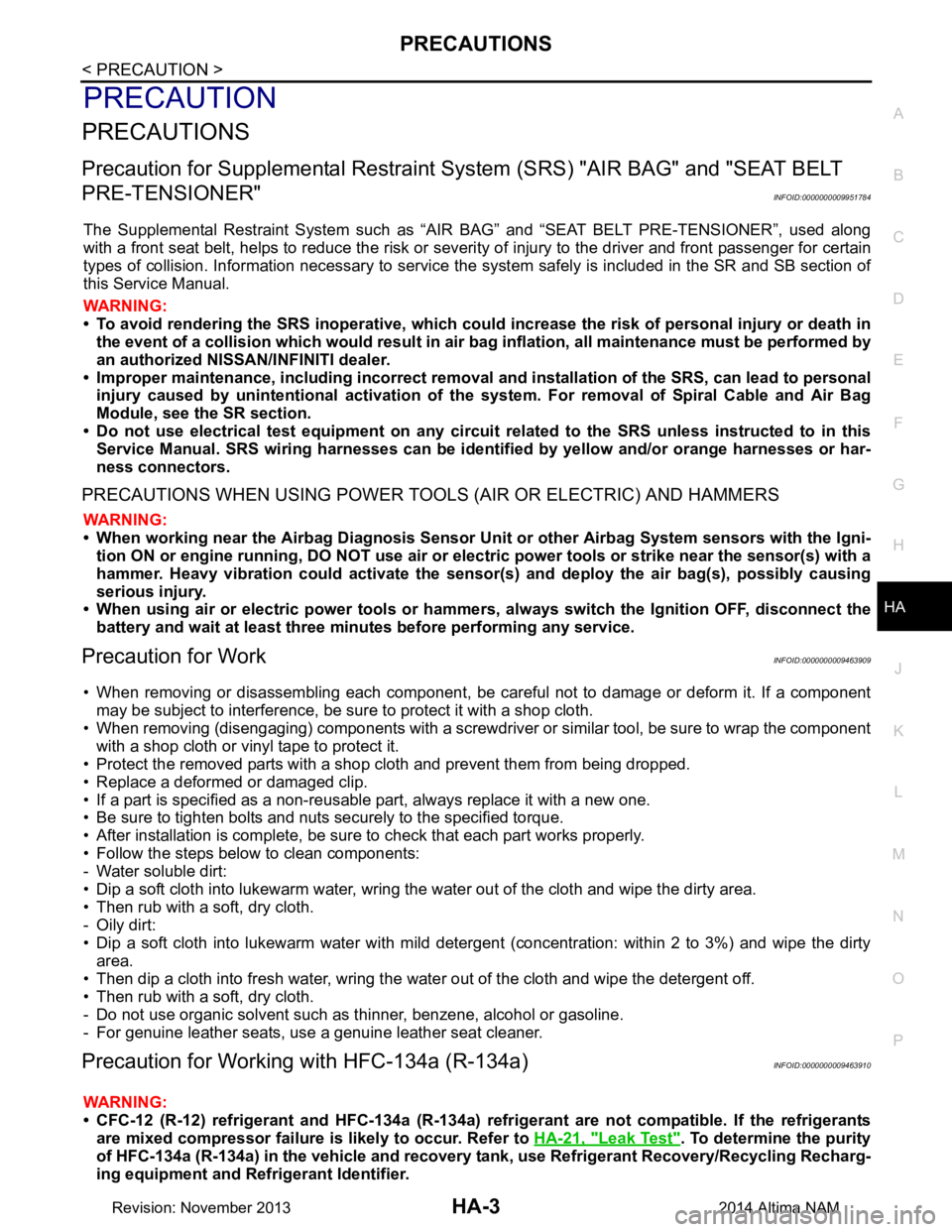
PRECAUTIONSHA-3
< PRECAUTION >
C
D E
F
G H
J
K L
M A
B
HA
N
O P
PRECAUTION
PRECAUTIONS
Precaution for Supplemental Restraint System (SRS) "AIR BAG" and "SEAT BELT
PRE-TENSIONER"
INFOID:0000000009951784
The Supplemental Restraint System such as “A IR BAG” and “SEAT BELT PRE-TENSIONER”, used along
with a front seat belt, helps to reduce the risk or severi ty of injury to the driver and front passenger for certain
types of collision. Information necessary to service t he system safely is included in the SR and SB section of
this Service Manual.
WARNING:
• To avoid rendering the SRS inoper ative, which could increase the risk of personal injury or death in
the event of a collision which would result in air bag inflation, all maintenance must be performed by
an authorized NISSAN/INFINITI dealer.
• Improper maintenance, including in correct removal and installation of the SRS, can lead to personal
injury caused by unintentional act ivation of the system. For removal of Spiral Cable and Air Bag
Module, see the SR section.
• Do not use electrical test equipm ent on any circuit related to the SRS unless instructed to in this
Service Manual. SRS wiring harnesses can be identi fied by yellow and/or orange harnesses or har-
ness connectors.
PRECAUTIONS WHEN USING POWER TOOLS (AIR OR ELECTRIC) AND HAMMERS
WARNING:
• When working near the Airbag Diagnosis Sensor Un it or other Airbag System sensors with the Igni-
tion ON or engine running, DO NOT use air or el ectric power tools or strike near the sensor(s) with a
hammer. Heavy vibration could activate the sensor( s) and deploy the air bag(s), possibly causing
serious injury.
• When using air or electric power tools or hammers , always switch the Ignition OFF, disconnect the
battery and wait at least three mi nutes before performing any service.
Precaution for WorkINFOID:0000000009463909
• When removing or disassembling each component, be ca reful not to damage or deform it. If a component
may be subject to interference, be sure to protect it with a shop cloth.
• When removing (disengaging) components with a screwdriver or similar tool, be sure to wrap the component with a shop cloth or vinyl tape to protect it.
• Protect the removed parts with a shop cloth and prevent them from being dropped.
• Replace a deformed or damaged clip.
• If a part is specified as a non-reusabl e part, always replace it with a new one.
• Be sure to tighten bolts and nuts securely to the specified torque.
• After installation is complete, be sure to check that each part works properly.
• Follow the steps below to clean components:
- Water soluble dirt:
• Dip a soft cloth into lukewarm water, wring the water out of the cloth and wipe the dirty area.
• Then rub with a soft, dry cloth.
-Oily dirt:
• Dip a soft cloth into lukewarm water with mild detergent (concentration: within 2 to 3%) and wipe the dirty area.
• Then dip a cloth into fresh water, wring the water out of the cloth and wipe the detergent off.
• Then rub with a soft, dry cloth.
- Do not use organic solvent such as thinner, benzene, alcohol or gasoline.
- For genuine leather seats, use a genuine leather seat cleaner.
Precaution for Workin g with HFC-134a (R-134a)INFOID:0000000009463910
WARNING:
• CFC-12 (R-12) refrigerant and HFC-134a (R-134a) refr igerant are not compatible. If the refrigerants
are mixed compressor failure is likely to occur. Refer to HA-21, "Leak Test"
. To determine the purity
of HFC-134a (R-134a) in the vehicle and recovery tank, use Refrigerant Recovery/Recycling Recharg-
ing equipment and Refrigerant Identifier.
Revision: November 20132014 Altima NAM
Page 2610 of 4801

HA-4
< PRECAUTION >
PRECAUTIONS
• Use only specified oil for the HFC-134a (R-134a) A/C system and HFC-134a (R-134a) components. If
oil other than that specified is used , compressor failure is likely to occur.
• The specified HFC-134a (R-134a) oi l rapidly absorbs moisture from the atmosphere. The following
handling precautions must be observed:
- When removing refrigerant components from a vehicle, immediately cap (seal) the component to
minimize the entry of moisture from the atmosphere.
- When installing refrigerant co mponents to a vehicle, do not remove the caps (unseal) until just
before connecting the components . Connect all refrigerant loop components as quickly as possible
to minimize the entry of moisture into system.
- Only use the specified oil from a sealed container. Immediately reseal containers of oil. Without
proper sealing, oil will become moisture saturat ed and should not be used.
- Avoid breathing A/C refrigerant and oil vapor or mist. Exposure may irritate eyes, nose and throat.
Remove HFC-134a (R-134a) from the A/C system usin g certified service equipment meeting require-
ments of SAE J2210 [HFC-134a (R-134a) recycling equipment], or J2209 [HFC-134a (R-134a) recy-
cling equipment], If accidental system discharge occurs, ventilate work area before resuming
service. Additional health and safety information may be obtain ed from refrigerant and oil manufac-
turers.
- Do not allow A/C oil to come in contact with styrofoam parts. Damage may result.
Contaminated RefrigerantINFOID:0000000009463911
If a refrigerant other than pure HFC-134a (R-134a) is identified in a vehicle, your options are:
• Explain to the customer that environmental regulations prohibit the release of contaminated refrigerant into
the atmosphere.
• Explain that recovery of the contaminated refri gerant could damage your service equipment and refrigerant
supply.
• Suggest the customer return the vehicle to the locati on of previous service where the contamination may
have occurred.
• If you choose to perform the repair, recover the refrigerant using only dedicated equipment and contain-
ers. Do not recover contamin ated refrigerant into your existing service equipment. If your facility does
not have dedicated recovery equipment, you may contact a local refrigerant product retailer for available ser-
vice. This refrigerant must be disposed of in acco rdance with all federal and local regulations. In addition,
replacement of all refrigerant system components on the vehicle is recommended.
• If the vehicle is within the warranty period, the air conditioner warranty is void. Please contact NISSAN Cus-
tomer Affairs for further assistance.
Precaution for Leak Detection DyeINFOID:0000000009463912
• The A/C system contains a fluorescent leak detection dye used for locating refrigerant leaks. An ultraviolet
(UV) lamp is required to illuminate the dye when inspecting for leaks.
• Always wear fluorescence enhancing UV safety goggles to protect your eyes and enhance the visibility of
the fluorescent dye.
• A compressor shaft seal should not be repaired because of dye seepage. The compressor shaft seal should only be repaired after confirming the leak with an electronic refrigerant leak detector (J-41995).
• Always remove any dye from the leak area after repairs are complete to avoid a misdiagnosis during a future
service.
• Do not allow dye to come into contact with painted body panels or interior components. If dye is spilled,
clean immediately with the approved dye cleaner. Fluoresc ent dye left on a surface for an extended period of
time cannot be removed .
• Do not spray the fluorescent dye cleaning agent on hot surfaces (engine exhaust manifold, etc.).
• Do not use more than one refrigerant dye bottle (1/4 ounce / 7.4 cc) per A/C system.
• Leak detection dyes for HFC-134a (R-134a) and HC-12 (R- 12) A/C systems are different. Do not use HFC-
134a (R-134a) leak detection dye in R-12 A/C systems or HC-12 (R-12) leak detection dye in HFC-134a (R-
134a) A/C systems or A/C system damage may result.
• The fluorescent properties of the dye will remain for ov er three (3) years unless a compressor failure occurs.
Precaution for Refrigerant ConnectionINFOID:0000000009463913
A new type refrigerant connection has been introduced to al l refrigerant lines except the following locations.
• Expansion valve to cooling unit
• Evaporator pipes to evaporator (inside cooling unit)
• Refrigerant pressure sensor
Revision: November 20132014 Altima NAM
Page 2619 of 4801
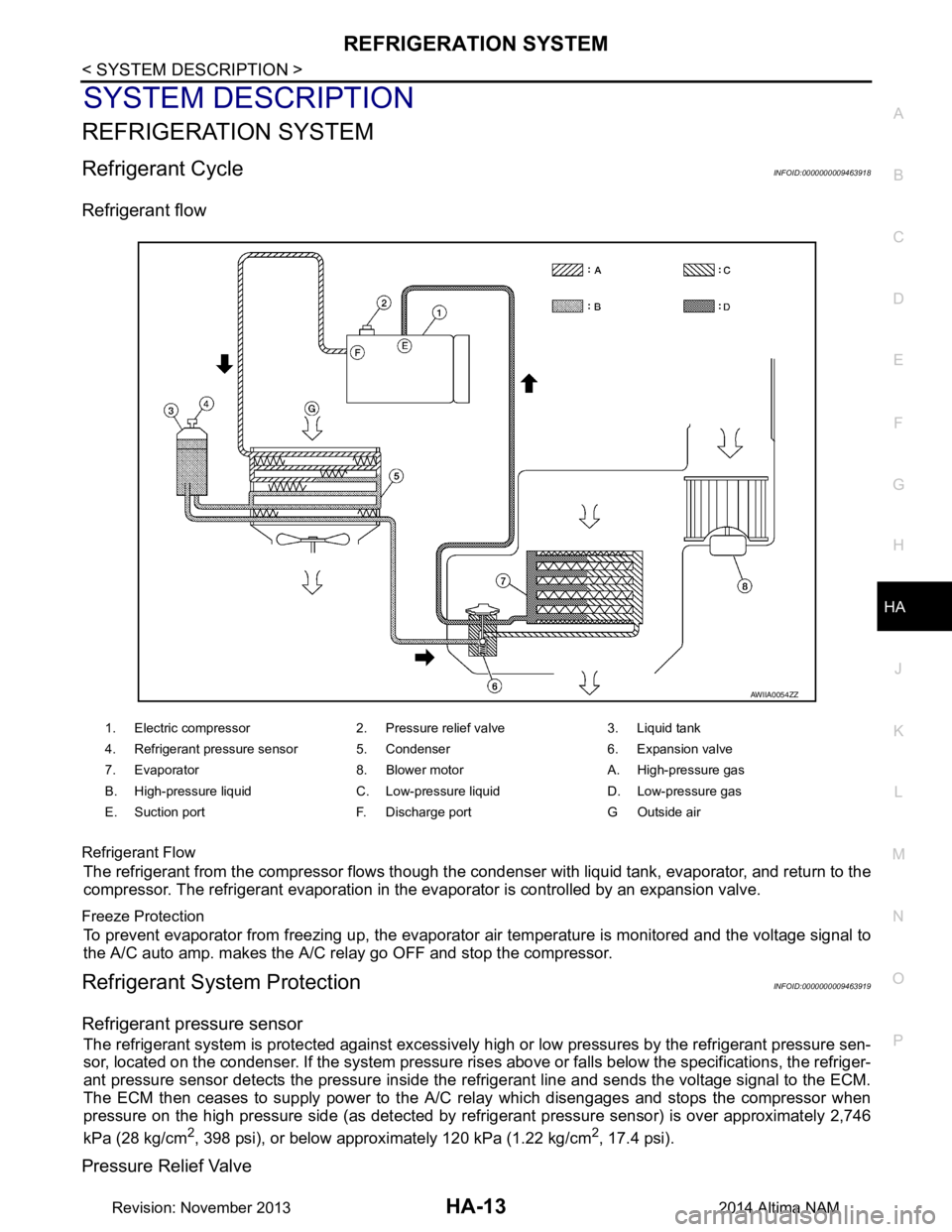
REFRIGERATION SYSTEMHA-13
< SYSTEM DESCRIPTION >
C
D E
F
G H
J
K L
M A
B
HA
N
O P
SYSTEM DESCRIPTION
REFRIGERATION SYSTEM
Refrigerant CycleINFOID:0000000009463918
Refrigerant flow
Refrigerant Flow
The refrigerant from the compressor flows though the c ondenser with liquid tank, evaporator, and return to the
compressor. The refrigerant evaporation in the evaporator is controlled by an expansion valve.
Freeze Protection
To prevent evaporator from freezing up, the evaporator air temperature is monitored and the voltage signal to
the A/C auto amp. makes the A/C relay go OFF and stop the compressor.
Refrigerant System ProtectionINFOID:0000000009463919
Refrigerant pressure sensor
The refrigerant system is protected against excessively hi gh or low pressures by the refrigerant pressure sen-
sor, located on the condenser. If the system pressure rise s above or falls below the specifications, the refriger-
ant pressure sensor detects the pressure inside the refrigerant line and sends the voltage signal to the ECM.
The ECM then ceases to supply power to the A/C relay which disengages and stops the compressor when
pressure on the high pressure side (as detected by refr igerant pressure sensor) is over approximately 2,746
kPa (28 kg/cm
2, 398 psi), or below approximately 120 kPa (1.22 kg/cm2, 17.4 psi).
Pressure Relief Valve
1. Electric compressor 2. Pressure relief valve 3. Liquid tank
4. Refrigerant pressure sensor 5. Condenser 6. Expansion valve
7. Evaporator 8. Blower motor A. High-pressure gas
B. High-pressure liquid C. Low-pressure liquid D. Low-pressure gas
E. Suction port F. Discharge port G Outside air
AWIIA0054ZZ
Revision: November 20132014 Altima NAM
Page 2625 of 4801
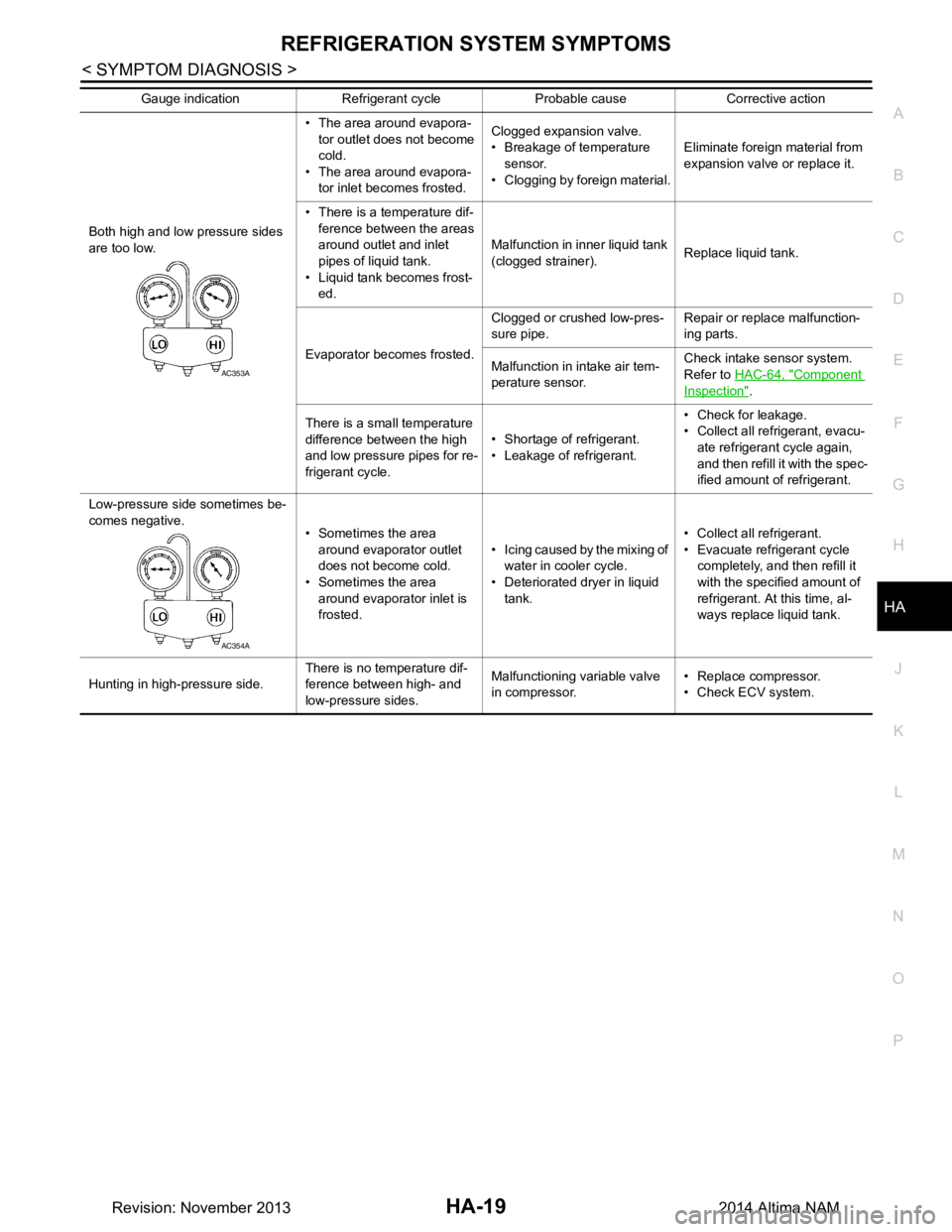
REFRIGERATION SYSTEM SYMPTOMSHA-19
< SYMPTOM DIAGNOSIS >
C
D E
F
G H
J
K L
M A
B
HA
N
O P
Both high and low pressure sides
are too low. • The area around evapora-
tor outlet does not become
cold.
• The area around evapora- tor inlet becomes frosted. Clogged expansion valve.
• Breakage of temperature sensor.
• Clogging by foreign material. Eliminate foreign material from
expansion valve or replace it.
• There is a temperature dif- ference between the areas
around outlet and inlet
pipes of liquid tank.
• Liquid tank becomes frost- ed. Malfunction in inner liquid tank
(clogged strainer). Replace liquid tank.
Evaporator becomes frosted. Clogged or crushed low-pres-
sure pipe. Repair or replace malfunction-
ing parts.
Malfunction in intake air tem-
perature sensor. Check intake sensor system.
Refer to HAC-64, "Component
Inspection".
There is a small temperature
difference between the high
and low pressure pipes for re-
frigerant cycle. • Shortage of refrigerant.
• Leakage of refrigerant. • Check for leakage.
• Collect all refrigerant, evacu-
ate refrigerant cycle again,
and then refill it with the spec-
ified amount of refrigerant.
Low-pressure side sometimes be-
comes negative. • Sometimes the area
around evaporator outlet
does not become cold.
• Sometimes the area
around evaporator inlet is
frosted. • Icing caused by the mixing of
water in cooler cycle.
• Deteriorated dryer in liquid
tank. • Collect all refrigerant.
• Evacuate refrigerant cycle completely, and then refill it
with the specified amount of
refrigerant. At this time, al-
ways replace liquid tank.
Hunting in high-pressure side. There is no temperature dif-
ference between high- and
low-pressure sides. Malfunctioning variable valve
in compressor. • Replace compressor.
• Check ECV system.
Gauge indication Refrigerant cycle Probable cause Corrective action
AC353A
AC354A
Revision: November 20132014 Altima NAM
Page 2644 of 4801

HA-38
< REMOVAL AND INSTALLATION >
CONDENSER
CONDENSER
Exploded ViewINFOID:0000000009463944
CONDENSER
CONDENSER : Removal and InstallationINFOID:0000000009463945
REMOVAL
1. Discharge the refrigerant. Refer to HA-23, "Recycle Refrigerant".
2. Remove the front bumper fascia. Refer to EXT-17, "Removal and Installation"
.
3. Remove the front air duct. Refer to EM-29, "Removal and Installation"
(QR25DE) or EM-144, "Removal
and Installation" (VQ35DE).
4. Disconnect the refrigerant lines from the condenser.
5. Remove the condenser.
INSTALLATION
Installation is in the reverse order of removal.
CAUTION:
After charging refrigerant, check for leaks. Refer to HA-21, "Leak Test"
.
LIQUID TANK
LIQUID TANK : Removal and InstallationINFOID:0000000009463946
REMOVAL
CAUTION:
Cap or wrap the joint of the hose with a suitable ma terial such as vinyl tape to avoid the entry of con-
taminants.
1. Discharge the refrigerant. Refer to HA-23, "Recycle Refrigerant"
.
2. Remove the front fascia. Refer to EXT-17, "Removal and Installation"
.
3. Clean liquid tank and its surrounding area, and remove dirt and rust from liquid tank. CAUTION:
Be sure to clean carefully.
1. Condenser air deflector (RH) 2. Condenser pipe assembly 3. Condenser
4. Refrigerant pressure sensor 5. Liquid tank 6. Condenser air deflector (LH)
Front
ALIIA0622ZZ
Revision: November 20132014 Altima NAM
Page 2645 of 4801
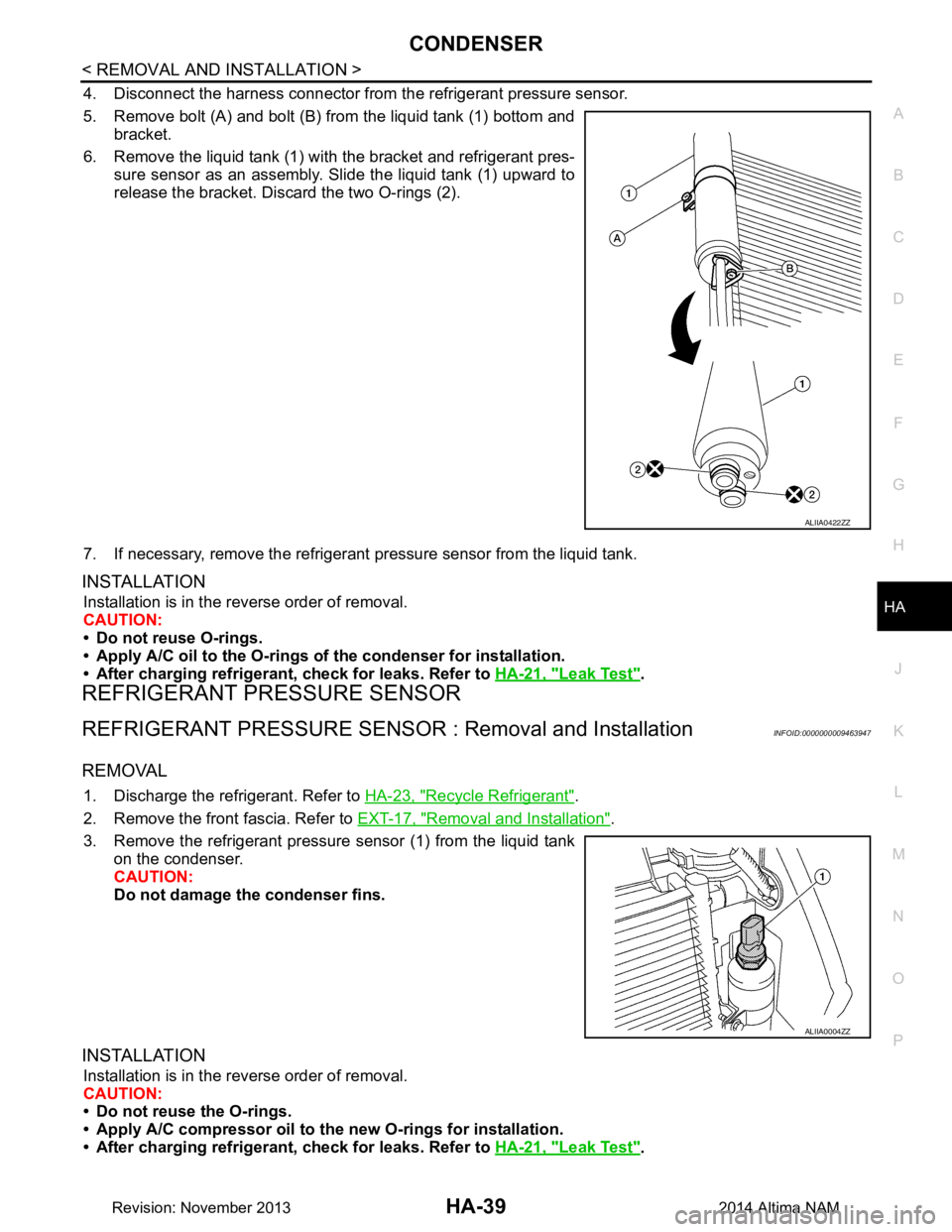
CONDENSERHA-39
< REMOVAL AND INSTALLATION >
C
D E
F
G H
J
K L
M A
B
HA
N
O P
4. Disconnect the harness connector from the refrigerant pressure sensor.
5. Remove bolt (A) and bolt (B) from the liquid tank (1) bottom and bracket.
6. Remove the liquid tank (1) with the bracket and refrigerant pres-
sure sensor as an assembly. Slide the liquid tank (1) upward to
release the bracket. Discard the two O-rings (2).
7. If necessary, remove the refrigerant pressure sensor from the liquid tank.
INSTALLATION
Installation is in the reverse order of removal.
CAUTION:
• Do not reuse O-rings.
• Apply A/C oil to the O-rings of the condenser for installation.
• After charging refrigerant, check for leaks. Refer to HA-21, "Leak Test"
.
REFRIGERANT PRESSURE SENSOR
REFRIGERANT PRESSURE SENSOR : Removal and InstallationINFOID:0000000009463947
REMOVAL
1. Discharge the refrigerant. Refer to HA-23, "Recycle Refrigerant".
2. Remove the front fascia. Refer to EXT-17, "Removal and Installation"
.
3. Remove the refrigerant pressure sensor (1) from the liquid tank on the condenser.
CAUTION:
Do not damage the condenser fins.
INSTALLATION
Installation is in the reverse order of removal.
CAUTION:
• Do not reuse the O-rings.
• Apply A/C compressor oil to th e new O-rings for installation.
• After charging refrigerant, check for leaks. Refer to HA-21, "Leak Test"
.
ALIIA0422ZZ
ALIIA0004ZZ
Revision: November 20132014 Altima NAM
Page 2648 of 4801
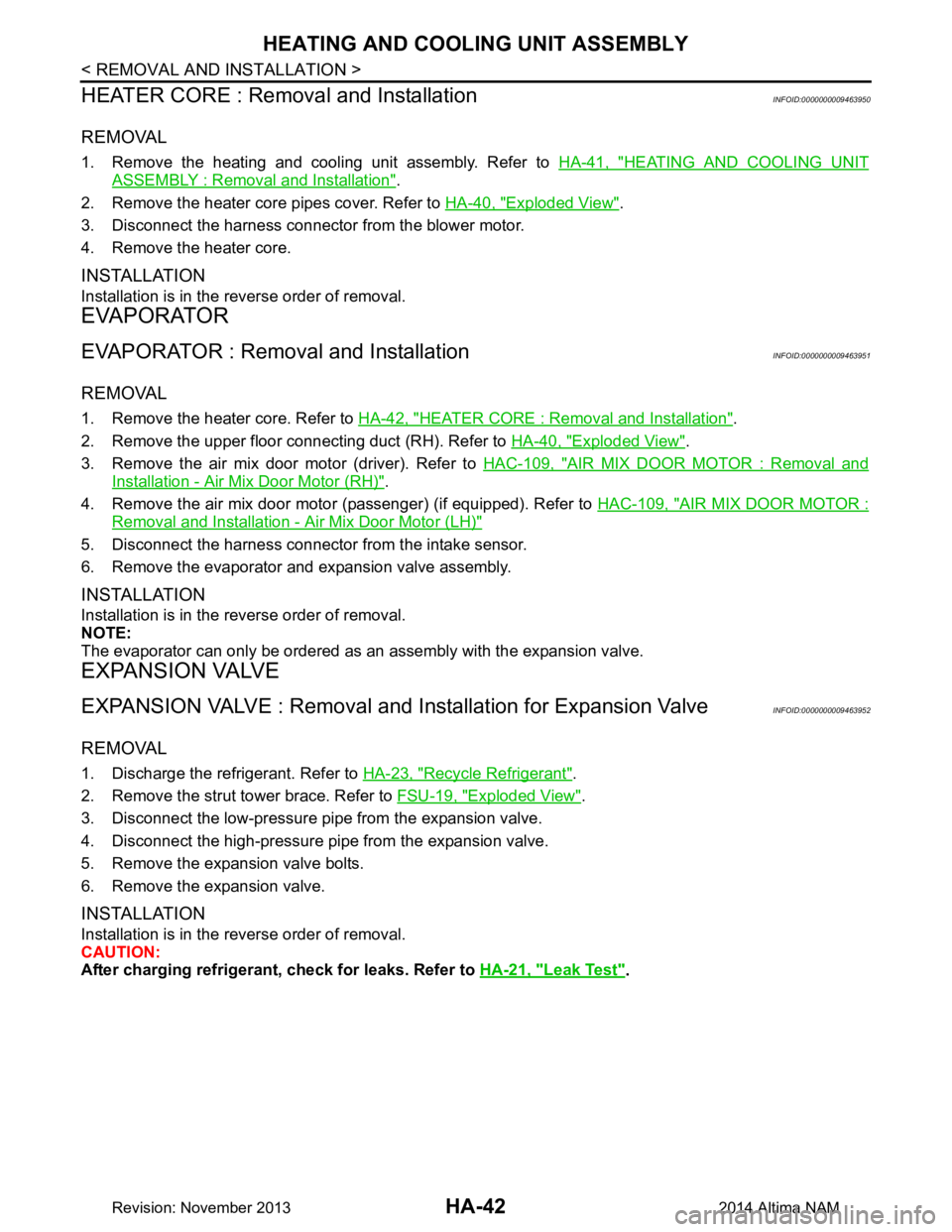
HA-42
< REMOVAL AND INSTALLATION >
HEATING AND COOLING UNIT ASSEMBLY
HEATER CORE : Removal and Installation
INFOID:0000000009463950
REMOVAL
1. Remove the heating and cooling unit assembly. Refer to HA-41, "HEATING AND COOLING UNIT
ASSEMBLY : Removal and Installation".
2. Remove the heater core pipes cover. Refer to HA-40, "Exploded View"
.
3. Disconnect the harness connector from the blower motor.
4. Remove the heater core.
INSTALLATION
Installation is in the reverse order of removal.
EVAPORATOR
EVAPORATOR : Removal and InstallationINFOID:0000000009463951
REMOVAL
1. Remove the heater core. Refer to HA-42, "HEATER CORE : Removal and Installation".
2. Remove the upper floor connecting duct (RH). Refer to HA-40, "Exploded View"
.
3. Remove the air mix door motor (driver). Refer to HAC-109, "AIR MIX DOOR MOTOR : Removal and
Installation - Air Mix Door Motor (RH)".
4. Remove the air mix door motor (passenger) (if equipped). Refer to HAC-109, "AIR MIX DOOR MOTOR :
Removal and Installation - Air Mix Door Motor (LH)"
5. Disconnect the harness connector from the intake sensor.
6. Remove the evaporator and expansion valve assembly.
INSTALLATION
Installation is in the reverse order of removal.
NOTE:
The evaporator can only be ordered as an assembly with the expansion valve.
EXPANSION VALVE
EXPANSION VALVE : Removal and Installation for Expansion ValveINFOID:0000000009463952
REMOVAL
1. Discharge the refrigerant. Refer to HA-23, "Recycle Refrigerant".
2. Remove the strut tower brace. Refer to FSU-19, "Exploded View"
.
3. Disconnect the low-pressure pipe from the expansion valve.
4. Disconnect the high-pressure pipe from the expansion valve.
5. Remove the expansion valve bolts.
6. Remove the expansion valve.
INSTALLATION
Installation is in the reverse order of removal.
CAUTION:
After charging refrigerant, check for leaks. Refer to HA-21, "Leak Test"
.
Revision: November 20132014 Altima NAM
Page 2651 of 4801

HAC-2
Diagnosis Procedure ..............................................55
U1010 CONTROL UNIT (CAN) .........................56
Description ........................................................... ...56
DTC Logic ...............................................................56
Diagnosis Procedure ..............................................56
B2578, B2579 IN-VEHICLE SENSOR ...............57
DTC Logic ............................................................ ...57
Diagnosis Procedure ..............................................57
Component Inspection ............................................58
B257B, B257C AMBIENT SENSOR .................60
DTC Logic ............................................................ ...60
Diagnosis Procedure ..............................................60
Component Inspection ............................................61
B2581, B2582 INTAKE SENSOR ......................63
DTC Logic ............................................................ ...63
Diagnosis Procedure ..............................................63
Component Inspection ............................................64
B2630, B2631 SUNLOAD SENSOR .................66
DTC Logic ............................................................ ...66
Diagnosis Procedure ..............................................66
Component Inspection ............................................67
B2632, B2633 AIR MIX DOOR MOTOR
(DRIVER SIDE) ............................................... ...
69
DTC Logic ............................................................ ...69
Diagnosis Procedure ..............................................69
B2634, B2635 AIR MIX DOOR MOTOR (PAS-
SENGER SIDE) ............................................... ...
71
DTC Logic ............................................................ ...71
Diagnosis Procedure ..............................................71
B2636, B2637, B2638, B2639, B2654, B2655
MODE DOOR MOTOR ................................... ...
73
DTC Logic ............................................................ ...73
Diagnosis Procedure ..............................................73
B263D, B263E, B263F INTAKE DOOR MO-
TOR ................................................................. ...
75
DTC Logic ............................................................ ...75
Diagnosis Procedure ..............................................75
B27B0 A/C AUTO AMP. ....................................77
DTC Logic ............................................................ ...77
Diagnosis Procedure ..............................................77
POWER SUPPLY AND GROUND CIRCUIT .....78
A/C AUTO AMP. .................................................... ...78
A/C AUTO AMP. : Diagnosis Procedure ................78
AIR MIX DOOR MOTOR (DRIVER SIDE) .............. ...78
AIR MIX DOOR MOTOR (DRIVER SIDE) : Diag-
nosis Procedure ................................................... ...
78
AIR MIX DOOR MOTOR (PASSENGER SIDE) ..... ...79
AIR MIX DOOR MOTOR (PASSENGER SIDE) :
Diagnosis Procedure ............................................ ...
79
MODE DOOR MOTOR ........................................... ...80
MODE DOOR MOTOR : Diagnosis Procedure .......80
INTAKE DOOR MOTOR ........................................ ...81
INTAKE DOOR MOTOR : Diagnosis Procedure ....81
A/C SWITCH ASSEMBLY .........................................82
A/C SWITCH ASSEMBLY : Component Function
Check ................................................................... ...
82
A/C SWITCH ASSEMBLY : Diagnosis Procedure ...83
BLOWER MOTOR .......................................... ...84
Diagnosis Procedure ............................................ ...84
Component Inspection (Blower Motor) ...................85
Component Inspection (Front Blower Motor Re-
lay) ....................................................................... ...
85
MAGNET CLUTCH ............................................87
Component Function Check ................................ ...87
Diagnosis Procedure ...............................................87
A/C SWITCH ASSEMBLY SIGNAL CIRCUIT ...88
Diagnosis Procedure ...............................................88
DOOR MOTOR ..................................................89
Diagnosis Procedure ............................................ ...89
DOOR MOTOR COMMUNICATION CIRCUIT ...91
Diagnosis Procedure ............................................ ...91
ECV (ELECTRICAL CONTROL VALVE) ..........92
Diagnosis Procedure ............................................ ...92
Component Inspection ............................................93
SYMPTOM DIAGNOSIS ............................94
HEATER AND AIR CONDITIONING SYSTEM
CONTROL SYMPTOMS ................................. ...
94
Diagnosis Chart By Symptom .............................. ...94
INSUFFICIENT COOLING .................................96
Description ........................................................... ...96
Diagnosis Procedure ...............................................96
INSUFFICIENT HEATING .................................98
Description ........................................................... ...98
Diagnosis Procedure ...............................................98
COMPRESSOR DOES NOT OPERATE ...........99
Description ........................................................... ...99
Diagnosis Procedure ...............................................99
REMOVAL AND INSTALLATION .............101
A/C SWITCH ASSEMBLY .............................. ..101
Removal and Installation .......................................101
A/C AUTO AMP. ............................................. ..102
Exploded View ..................................................... .102
Removal and Installation .......................................102
Revision: November 20132014 Altima NAMRevision: November 20132014 Altima NAM